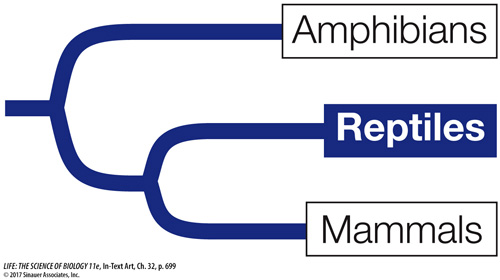Reptiles adapted to life in many habitats

The lineage leading to modern reptiles began to diverge from other amniotes more than 300 million years ago. More than 19,000 species of reptiles exist today, more than half of which are birds. Birds are the only living representatives of the otherwise extinct dinosaurs, the dominant terrestrial vertebrates of the Mesozoic.
The lepidosaurs constitute the second most species-

The skin of a lepidosaur is covered with horny scales that greatly reduce loss of water from the body surface. These scales, however, make the skin unavailable as an organ of gas exchange. Gases are exchanged almost entirely via the lungs, which are proportionally much larger in surface area than those of amphibians. A lepidosaur forces air into and out of its lungs by bellows-
Most lizards are insectivores, although some are herbivores and a few prey on other vertebrates. Most lizards walk on four limbs (Figure 32.21B), although limblessness has evolved repeatedly among the lizards, especially in burrowing and grassland species. The largest lizard is the predaceous Komodo dragon of the East Indies, which grows as long as 3 meters and can weigh more than 150 kilograms.
Media Clip 32.5 Komodo Dragons Bring Down Prey
The major group of limbless squamates is the snakes (Figure 32.21C). All snakes are carnivores, and many can swallow objects much larger than themselves. Several snake groups possess venom glands and the ability to inject venom rapidly into their prey.
The turtles comprise a reptilian group that has changed relatively little since the early Mesozoic. In these reptiles, dorsal and ventral bony plates form a shell into which the head and limbs can be withdrawn in many species (Figure 32.21D). The dorsal shell is a modification of the ribs. It is notable that pectoral girdles are inside the ribs of turtles, making them unlike any other vertebrates. Most turtles live in aquatic environments, but several groups, such as tortoises and box turtles, are terrestrial. Sea turtles spend their entire lives at sea except when they come ashore to lay eggs. Human exploitation of sea turtles and their eggs has resulted in worldwide declines of these species, all of which are now endangered. A few species of turtles are strict herbivores or carnivores, but most species are omnivores that eat a variety of aquatic and terrestrial plants and animals.